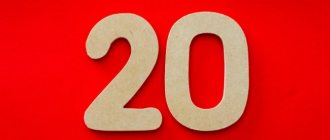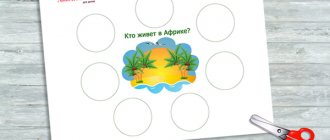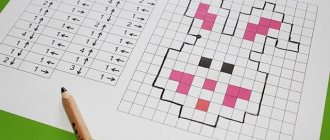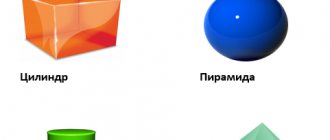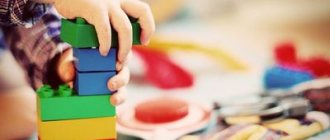Children at the age of 5 should already show an interest in mathematics, be able to count, understand what numbers are, know the numbers of the natural series, understand tens, solve arithmetic problems, and practice composing difficult problems. During these years, it would be better to start introducing children to letters, it would be good to teach children to read, and focus on sounds. Preschoolers must imagine what days of the week, months, and seasons there are. It is necessary to use special sets and visual materials for teaching preschool children. There is no need to let your preschooler get bored.
Mathematics in pictures No. 1
Mathematics in pictures No. 2
Mathematics in pictures No. 3
Mathematics in pictures No. 4
This article describes part of a lesson with five-year-old children (CLUB OF THE FUN AND REVENTIVES). Between thematic tasks, there are pictures in which you can also get ideas for math classes with children 5 years old.
Math task in pictures No. 5
Logic puzzles for preschoolers 5-6 years old (for attentiveness, memory development)
10 interesting and exciting tasks for preschoolers. Source: www.liveinternet.ru
Task 1: Katya, Galya and Olya drew heroes from the village of Prostokvashino: Pechkin, Sharik and Matroskin. Who drew who, if Katya didn’t draw Pechkin and Sharik, and Galya didn’t draw Pechkin?
Task 2: There is a maple tree. There are two branches on the maple tree, on each branch there are two cherries. How many cherries are there in total?
Problem 3: If a goose stands on two legs, then it weighs 4 kg. How much will a goose weigh if it stands on one leg?
Problem 4: Two sisters have one brother each. How many children are in the family?
Problem 5: A giraffe, a crocodile and a hippopotamus lived in different houses. The giraffe did not live in a red or blue house. The crocodile did not live in a red or orange house. Guess which houses the animals lived in?
Problem 6: Once upon a time there were three girls: Tanya, Lena and Dasha. Tanya is taller than Lena, Lena is taller than Dasha. Which girl is the tallest and which is the shortest? What is the name of which one?
Problem 7: Misha has three carts of different colors: red, yellow and blue. Misha also has three toys: a tumbler, a pyramid and a spinning top. In the red cart he will not carry a spinning top or a pyramid. The yellow one is not a spinning top or a tumbler. What will Misha carry in each of the carts?
Problem 8: The dragonfly is not sitting on a flower or on a leaf. The grasshopper does not sit on a fungus or on a flower. The ladybug is not sitting on a leaf or on a fungus. Who is sitting on what? (It’s better to draw everything.)
Problem 9: Alyosha, Sasha and Misha live on different floors. Alyosha lives neither on the top floor nor on the bottom. Sasha lives neither on the middle floor nor on the bottom. On what floor does each boy live?
Problem 10: Three plates contain different fruits. The bananas are not in a blue or an orange plate. Oranges are not in a blue or pink plate. What plate are the plums in? What about bananas and oranges?
How are results assessed?
For completing mathematics assignments for preschoolers 5 years old, the Razumeikin website provides a whole system of rewards. We are convinced that it helps to increase children's interest in learning and create positive motivation.
By completing the tasks in the “Mathematics for preschoolers 5 years old” section, kids receive a reward. Our website provides medals, cups, pennants and certificates.
Almost all task-games in the “Mathematics for 6-year-old children” section are graded depending on the attempt at which the child gave the correct answer. If necessary, you can return to the completed exercise. By doing the task in the section “Mathematics for preschoolers 5-6 years old” again, the child will be able to improve the previous result and receive a higher reward.
Before you start doing the exercises in the “Mathematics for children 5-6 years old” section, we recommend taking a test. The results obtained will help you understand which topics need to be discussed in more detail. In addition, parents will be able to determine which tasks in the “Mathematics for preschoolers 6 years old” section should be completed first.
Logical problems in mathematics for ingenuity and ingenuity with answers
AWARENESS TASKS
- There were 9 steamships at sea. 2 ships docked at the pier. How many ships are there at sea? (9 ships.)
- There were 7 brothers walking, each brother had one sister. How many people walked? (8 people).
- What kind of dishes can you not eat anything from? (From empty.)
- The animal has 2 right legs, 2 left legs, 2 legs in front, 2 in back. How many legs does an animal have? (4 legs.)
- 9 sharks were swimming in the sea. They saw a school of fish and dived deep. How many sharks swam in the sea? (9 sharks, only they dived.)
- The vase contains 3 tulips and 7 daffodils. How many tulips are there in a vase? (There were 3 tulips in the vase.)
- 7 boys cleared one path in the garden. How many paths did the boys clear? (7 tracks.)
- 2 brothers each drew 2 drawings as a gift to their grandfather. How many drawings did grandfather receive? (4 pictures.)
- The grandmother knitted scarves and mittens for her grandchildren. In total she knitted 3 scarves and 6 mittens. How many grandchildren did your grandmother have? (3 grandchildren - explain the answer.)
- Grandfather, grandmother, granddaughter, Bug, cat and mouse pulled and pulled and finally pulled out the turnip. How many eyes saw the turnip? (12 eyes.)
Children collected an autumn bouquet in the park. It contained 5 maple, 4 birch, 2 oak, 1 aspen leaves. How many different trees did the bouquet come from? (From 4 trees.)
logicheskie_zadachi
Lessons with cards
Let's look at several exercises that help develop a child's mathematical abilities. To conduct them, you will need cards with numbers from 1 to 10. Of course, parents can quickly and easily make them. However, it is much better to involve the child in this process, entrusting him with the most interesting and responsible work. So, let's prepare training cards. We invite the preschooler to independently divide the landscape sheet into four equal parts and cut out cards along the lines. Having counted out 10 pieces, we give them to the child and ask them to write a number on each and draw the corresponding number of pictures. These can be circles, flowers, hearts, etc. If a child has difficulty writing any numbers, you should help him with this. After the cards are ready, you can start studying:
"Place it in order"
This exercise will help your child remember numerical values and the concepts of “more and less.” We ask the preschooler to arrange the cards in order, starting with the smallest and ending with the largest number. The exercise not only helps to consolidate the studied material, but also perfectly trains memory and imagination.
"Compare the numbers"
After showing the child two cards, we invite you to compare them. To begin with, the preschooler names the meanings of the numbers, then answers the question which one is greater and by how many units. Then you should replace one of the cards and repeat the same questions. This activity can continue for quite a long time until the child loses interest in it.
"Count the objects"
Since, in addition to numbers, various images are printed on the cards, it is worth inviting the child to count them. You can also complicate the task by preparing sheets with drawings of various animals and a number series from 1 to 10. Having counted the number of animals, the preschooler must circle the corresponding number. As a rule, children really like this exercise and do not cause them any particular difficulties.
"Missing Numbers"
The child holds the cards in his hands. An adult tells him two numbers, for example, 1 and 4. The young student finds these cards and places them on the table at some distance from each other. Now he must fill in the gaps between the numbers and find the two missing links. Accordingly, these will be cards with numbers 2 and 3.
Copybooks and games
Number flashcards help little ones become familiar with basic math concepts.
With such material, memory and thinking develop. To get used to the pen, you can buy copybooks or write figures and numbers in a notebook yourself. Such classes are carried out from the age of 5. They develop perseverance. Copybooks help develop accurate writing skills. Entertaining mathematics for children 5 and 6 years old includes logic problems and educational games. You can come up with fun logical tasks yourself , for example, which is heavier: 1 kg of fluff or 1 kg of iron. Didactic or educational games are carried out in any setting (while walking, sitting in line at the pediatrician, etc.).
If the child loves drawing more than mathematics, it is better for parents to conduct classes in a playful way:
- Claps. The game develops mathematical abilities and auditory perception. The adult claps his hands with different frequencies and strength, and the child counts the number of beats.
- Focus. Small objects are clenched in a fist and hidden behind the back. A preschooler, knowing how many objects are in one hand, must count how many are hidden in the other fist. If he answered correctly, the adult guesses. If the answer is incorrect, the items are hidden in a different quantity.
- Extra. 20 pictures of different categories are cut out from magazines: plants, transport, food, furniture. Images of the same theme are laid out on the table. Several pictures from another category are added to them. The preschooler must find extraneous drawings by counting their number. The remaining images from the same category are also counted.
- Number. This group game is played with a ball. Children stand in a circle with an adult in the center. The ball is thrown one by one, and the number is called. Each kid must return the ball to the leader, saying the next number in order.
- Drawing. Arithmetic for 5 year olds should be fun. For this purpose, teachers have developed didactic materials with dot drawing lessons. Children, connecting elements, draw lines in order from one number to another.
- Walker. The path is marked on the playing field. You need to use it to get from one point to another. Children take turns throwing the dice, counting the number of dots they get, and make their moves. The count is limited from 1 to 12. If 6 and 3 are rolled, the child must calculate the sum of these numbers. The next move is made after the player adds the numbers correctly.
- Shop. Child sellers offer adult buyers to purchase products at different prices. You can make a real calculation if you go to the store with your child. Gradually, the baby will be able to determine the amount of change himself. Frequent trips to the store will help him learn to count faster.
Math games for preschoolers
These games will help your child become familiar with mathematics in the most interesting and exciting way because children love to play. Educational games are great for this.
Game "Quick Count"
The game "quick count" will help you improve your thinking . The essence of the game is that in the picture presented to you, you will need to choose the answer “yes” or “no” to the question “are there 5 identical fruits?” Follow your goal, and this game will help you with this.
Play now
Game "Piggy Bank"
I can’t resist recommending to you the game “Piggy Bank” from the same site where you need to register, indicating only your E-mail and password. This game will give you fitness for your brain and relaxation for your body. The essence of the game is to indicate 1 of 4 windows in which the amount of coins is the largest. Will you be able to show excellent results? We are waiting for you!
Play now
Game "Number Reach: Revolution"
An interesting and useful game “Numeric Span: Revolution”, which will help you improve and develop your memory . The essence of the game is that the monitor will display numbers in order, one at a time, which you should remember and then reproduce. Such chains will consist of 4, 5 and even 6 digits. Time is limited. How many points can you score in this game?
Play now
Game "Mathematical Comparisons"
A great game with which you can relax your body and tense your brain. The screenshot shows an example of this game, in which there will be a question related to the picture, and you will need to answer. Time is limited. How much time will you have to answer?
Play now
Airport game
The game "Airport" is an interesting game, the purpose of which is to show where the blue plane is flying and where the red one is coming from. This exercise will help develop such qualities as: intelligence, attention, speed of thought, speed of reaction. How many points can you score at the end of the game? Let's check!
Play now

